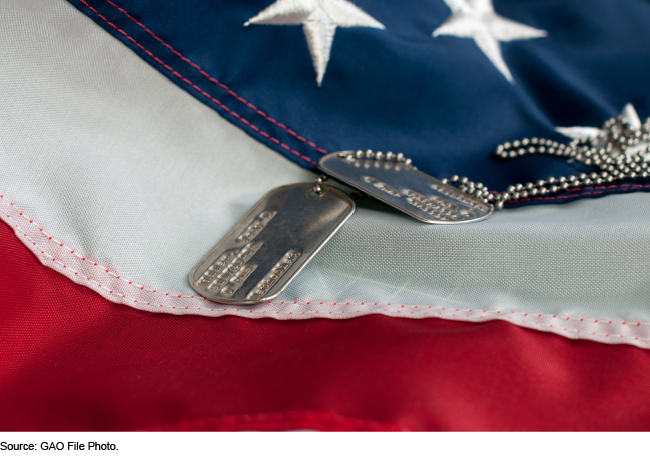Veterans Affairs: Improvements Needed in Estimating Funding for Potential Future Health Emergencies
Fast Facts
Veterans Affairs received about $36.7 billion in supplemental funds for its COVID-19 pandemic response. VA used the funds to support services at VA medical facilities and for new efforts like expanding IT infrastructure for telehealth services.
At the pandemic's start, the Veterans Health Administration requested funds to continue operations. But VHA didn't have the tools to develop a base estimate of potential costs for an emergency event like a pandemic.
Our recommendations address VA's need for an analytical model to build on lessons learned from the pandemic and to project costs for future emergencies.

Highlights
What GAO Found
As of September 30, 2023, the Department of Veterans Affairs (VA) obligated roughly $36.2 billion (98.6 percent) of its CARES Act, Families First Coronavirus Response Act, and American Rescue Plan Act of 2021 funds, with the majority obligated by its Veterans Health Administration (VHA).
VA Obligations of COVID-19 Supplemental Funding Totaled $36.2 Billion as of September 30, 2023

VA used COVID-19 supplemental funds to support new efforts in response to the pandemic, such as expanding VA's information technology infrastructure to provide telehealth services. It also used the funding to support already established VA programs, such as providing health care at VA medical facilities.
When the COVID-19 pandemic emerged, VHA requested supplemental funding to continue operations to meet its mission. However, VA found it was not prepared to estimate the amount of supplemental funding needed during such a catastrophic event, because it did not have the modeling capacity to do so. VHA officials told GAO they have not developed the modeling capacity needed to estimate the costs of future catastrophes, such as a pandemic, because such modeling is outside of the scope of its contract with its actuarial consultant responsible for developing VA's budget projections. By developing modeling capacity for estimating the resources needed to respond to potential future health emergencies, VHA would be better prepared to quickly estimate resource needs to allow better management and planning.
Why GAO Did This Study
In response to the COVID-19 pandemic, VA received approximately $36.70 billion in supplemental funding between 2020 and 2021. CARES Act and Families First Coronavirus Response Act funds were available until September 30, 2021, and September 30, 2022, respectively. American Rescue Plan Act of 2021 funds were generally available until September 30, 2023.
The VA Transparency & Trust Act of 2021 includes a provision for GAO to review VA's requests for and use of COVID-19 supplemental funding, including American Rescue Plan Act of 2021 funds. Among other issues, this report describes how VA used these funds and examines how VA estimated its funding needs to inform the fiscal year 2024 budget request for key areas previously supported with COVID-19 supplemental funds.
GAO reviewed VA data and spending plans for COVID-19 supplemental funding and VA processes used to develop budget request estimates for fiscal years 2022 through 2024. GAO also interviewed VA officials and VA's actuarial consultant responsible for developing estimates.
Recommendations
GAO is making two recommendations, including that VA enhance its modeling capacity to prepare estimates of the funding needed to meet the needs of veterans in the event of another pandemic or catastrophe. VA agreed with GAO's recommendations.
Recommendations for Executive Action
| Agency Affected | Recommendation | Status |
|---|---|---|
| Department of Veterans Affairs | The VA Undersecretary for Health should update VHA's standard operating procedure to require documenting and sharing with internal VHA stakeholders the rationale for key decisions made when developing the EHCPM. This should include documentation of key decisions made that led from the development of the initial EHCPM scenario through the scenario ultimately used to develop the President's budget request for VA. (Recommendation 1) |
The Department of Veterans Affairs (VA) concurred with our recommendation. As of October 2024, the Veterans Health Administration's (VHA) Office of Enrollment and Forecasting finalized a standard operating procedure (SOP) for developing Enrollee Health Care Projection Model (EHCPM) scenarios to support budget formulation. The SOP includes an approval memorandum template to provide consistent and standardized information on assumptions to VHA decision makers and will ensure proper documentation of VHA leadership decisions concerning EHCPM assumptions. We will continue to monitor VA's action to ensure the implementation of this SOP and documentation of VHA leadership decisions during the development of VHA's fiscal year 2026 budget request.
|
| Department of Veterans Affairs | The VA Undersecretary for Health should enhance VA's analytical modeling capacity to better enable VHA to prepare estimates of the supplemental funding needed to address catastrophic events, such as pandemics, natural disasters, and terrorist acts. (Recommendation 2) |
The Department of Veterans Affairs (VA) concurred with our recommendation. As of October 2024, the Veterans Health Administration's (VHA) Chief Strategy Office convened an internal Catastrophic Events Modeling workgroup to develop a draft charter to provide clear direction regarding the enhancement of the modeling capacity to prepare funding estimates to meet the needs of veterans in the event of another catastrophic event such as the COVID-19 pandemic. According to VHA officials, this charter is currently under review and will be approved at the workgroup's first meeting, which is planned to take place in the first quarter of fiscal year 2025. According to VHA officials, this workgroup was formed under the authority of VHA's Strategic Directions Committee that reviewed background information and plans for the workgroup on August 29, 2024. As an outcome of the presentation, representatives from the offices and organizations determined as key workgroup contributors were nominated as members of the workgroup. We will continue to monitor the actions of this workgroup and asses the charter to determine if it addresses the intent of our recommendation for VA to enhance its analytic modeling capacity to better enable VHA to prepare estimates of supplemental funding needed to address a future catastrophic event.
|
